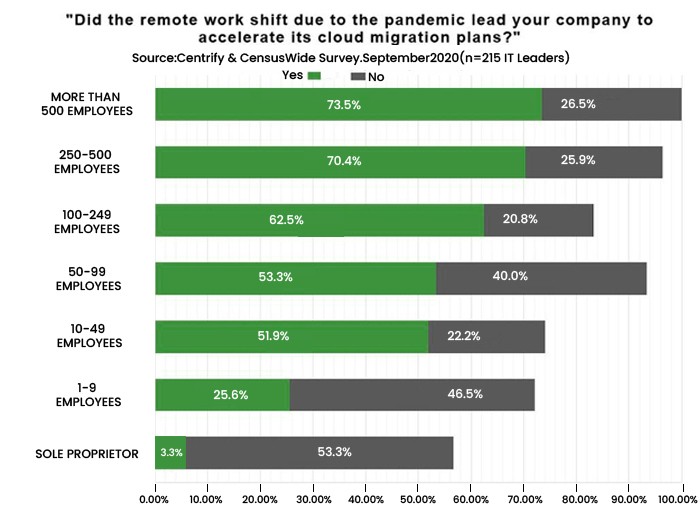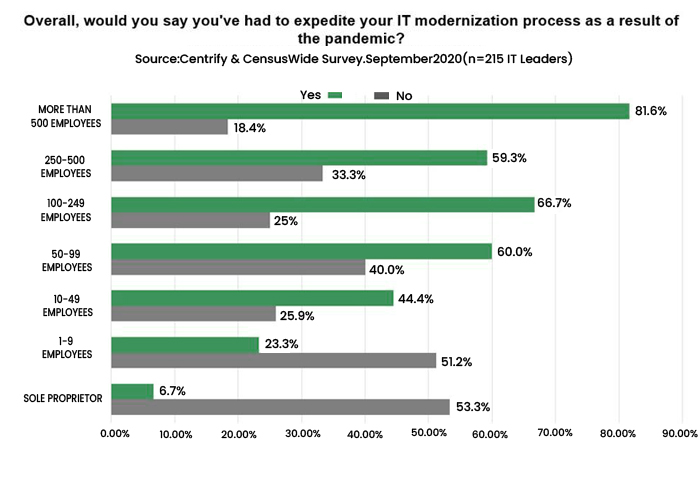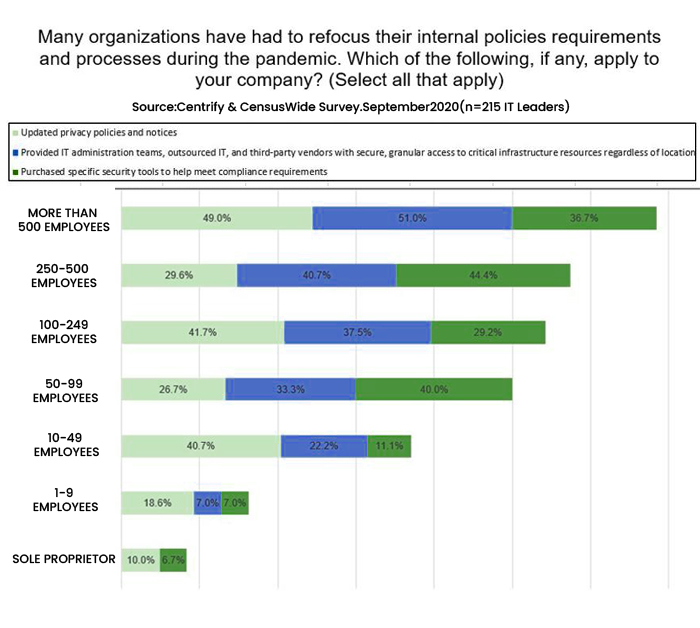83% Of Large-scale Enterprises Transformed Their Cybersecurity Due To Pandemic!
As the world gears up to combat the coronavirus pandemic and countries impose strict prevention measures, IT businesses struggle with the imminent challenge of business continuity.
With workforces at home, economic activities are grappling to keep pace and markets have plunged.
Now, more than ever, organizations are striving to reinvent themselves to adapt to the new normal and navigate the crisis by accelerating digital transmission, embracing remote working, establishing variable cost structures, and implementing agile operations.
A recent survey of IT leaders conducted by CensusWide and sponsored by Centrify offers some key insights on how the dynamics of IT investments, operations, and spending shifted over the last seven months of the pandemic. Key insights include:
a) 83% of large-scale enterprises transformed their cybersecurity approach
With the sudden transition to the remote working culture due to the pandemic, an overwhelming majority of organizations have transformed their cybersecurity approach over the last seven months. Among all organizations, large-scale enterprises lead the table, with 83% adjusting and improving their cybersecurity. Even the small and medium-size businesses have adjusted their security posture as a result of a distributed workforce.

b) 48% of organizations accelerated their cloud migration plans
The survey finds that 48% of the surveyed organizations have accelerated their cloud migration plans to accommodate remote work culture triggered by the pandemic. Over 73% of enterprises with over 500 employees advanced their cloud migration, leading all organization categories.

c) 49% of organizations expedited their IT modernization process
As per the survey, 49% of all surveyed organizations have boosted their IT modernization process as a result of the pandemic. Around 81% of the large-scale enterprises have accelerated their IT modernization process, leading all organization categories.
For large-scale organizations, IT modernization means digital transformation using cloud-native services (59%), enabling flexibility and security of partial remote workforce (57%), and adapting cybersecurity procedures (40%).

d) 51% of large-scale enterprises prioritized secure, granular access
During the pandemic, organizations are compelled to refocus their internal policies, requirements, and processes to navigate the crisis. As per the survey, 27% of surveyed organizations have highly prioritized providing IT admin teams, outsourced IT, and third-party vendors with secure, granular access to their critical infrastructure resources regardless of location. Meanwhile, 51% of large-scale enterprises have made providing secure, remote access their highest internal priority. The survey also reveals that around 45% of organizations with 250-500 employees have purchased specific cybersecurity tools and applications to meet compliance needs.

Some other key findings:
1) 34% of interviewed IT leaders say their budgets have increased during the pandemic
2) 59% of IT leaders in large-scale enterprises have seen their budgets increase amid the pandemic
3) 25% of IT leaders revealed that their organization plans to keep their entire workforce 100% remote
In Closing:
Amid the ongoing uncertainty, IT leaders must consider how the pandemic is impacting their recovery strategies. They must outplay uncertainty by reinventing themselves, again and again as circumstances change. To do so, organizations must reassess assumptions, re-evaluate scenarios, and enhance their ability to identify and respond.
More Articles:
- 25 Biggest Data Breaches That Made Headlines In 2020
- 7 Tips to Build an Effective Cyber Incident Response Plan
- Infographic: Do’s and Don’ts of Cybersecurity Incident Response
- Infographic: Why Do Organizations Need PAM Services?
- 6 Steps to Build an Effective Cyber Incident Response Plan
- Privileged Access Management (PAM) Services: Strategy and Benefits
- Best Practices to Accelerate Cloud IAM Adoption

